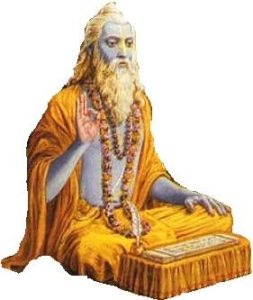Criticizing the Sruti-sastra
Sruti-sastra-nindanam
Glory to Gadadhara, Gauranga and Nityananda. Glory to Sita’s husband and devotees.
Hari Dasa said: Lord, the fourth offense is criticism of the Sruti-sastra. This criticism hinders bhakti-rasa.
The Vedas are the only proof
Amnaya-i eka-matra pramana
The Sruti-sastra, the Vedas, the Upanishads and the Puranas[1], all these pramanas[2] have arisen from the breath of Krishna.
Particularly, they contain knowledge of transcendental truths that are beyond the reach of the worldly senses[3]. The entire Veda is perfect.
That which transcends opaque matter is beyond the senses. Without the mercy of Krishna, one cannot perceive it.
In all human knowledge we find four things: imperfect senses[4], the tendency to make mistakes[5], the propensity to deceive[6], and the propensity to get confused[7].
The four Vedas are free from all these defects. Without the Vedas there is no other way to the highest goal.
Being extremely merciful towards the Jivas who have attached themselves to Maya, Krishna took the knowledge of the sages and placed it in the Vedas and Puranas[8].
The ten fundamental teachings and nine proofs found in the Vedas
Amnaya haite dasa-mula siksa prameya nayati
I know that the Sruti-sastra considers karma and jnana to be of the same value as ash[9], and that only the attainment of pure bhakti is essential.
The Jivas are deceived by Maya, who purifies them through karma and jnana, and when they are qualified Hari instructs them in suddha-bhakti[10].
The pramana of the Vedic statements reveals nine prameyas[11]. Their teachings are sambandha[12], abhidheya[13] and prayojana[14].
“The essence of this is the Dasa-mula[15], which destroy the ignorance of the Jiva and manifest divine knowledge.
[1] Technically the Srutis are the Vedas (or Amnayas) and the Upanisads, but here Haridasa Thakura inserts the Puranas as part of the Srutis. He’s not the only one to do it. Srila Vyasadeva, in the Maha-bharata itself, states this point very decisively.
[2] Proof or evidence.
[3] Aprakrta-tattva.
[4] Karanapatava.
[5] Bhrama.
[6] Vipralipsa.
[7] Pramada.
[8] Some mighty Rishis attained perfect knowledge through meditation (arsa-jnana). Krishna accepted it and had it written down in the Vedas.
[9] That is, no value.
[10] The idea expressed here is that karma and jnana give temporal benefits which are negligible for one who wants eternity.
[11] Objects of knowledge.
[12] The relationship between Jiva and Isvara.
[13] The method for spiritual realization.
[14] The final goal.
[15] The ten fundamental teachings, The Dasa-mula, state that there is one pramana, that is, the Vedic statements. There are nine prameyas: 1. Hari is the Supreme Truth. 2. His form is that of Syamasundara, and He is the master of all potencies. 3. The form of Syamasundara is full of supreme rasa; His abode is the spiritual sky. 4. Jivas are spiritual atomic particles (cit-paramanu) and are separate parts of Krishna (vibhinnamsa). The two types of Jivas are either eternally imprisoned in Maya (nitya-baddha) or eternally liberated (nitya-mukta). 5. The Jivas who are against Krishna are within Maya. 6. Pure devotees are free from the influence of Maya. 7. The Jivas and the entire world composed of gross matter are products of the potency that cannot be understood (acintya-sakti) and are manifestations eternally one and different from the Supreme. 8. Abhidheya-tattva refers to the nine processes in Krishna-bhakti. 9. Krishna-prema is the prayojana-tattva.
This is a section of the book “Harinama Cintamani (English)”.
To buy the complete book, click above




Leave a Reply